What tools you can use to effectively manage your Software Development project?
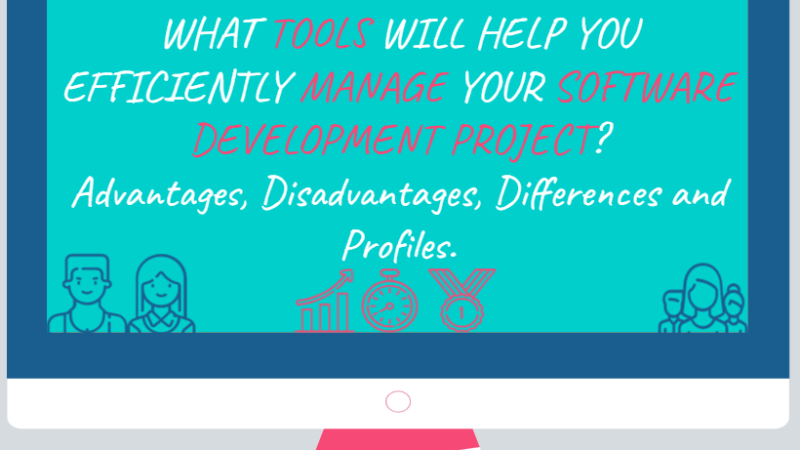
A guide to help you choose your Software Management Tool
What is software development ?
Software development involves all the tasks that brings a software project from conception to product delivery.
Software development is often conducted by software developers, software engineers, and programmers. These roles can overlap, and the dynamics between them can vary across development departments and communities.
This document is focused on searching for the best tools to make software development easier. Here we have a comparison between different tools. These tools help us gain efficiency when used wisely.
WHY ARE TOOLS IMPORTANT?
The purpose of a project management tool is to simplify managing projects. Its job is to automate the tasks of saving and managing time. In other words, when carrying a software project, teams face the “Quality Triangle” trade-off, which means a dilemma between providing a high quality result in an allocated time while lowering costs. When used wisely, tools can help achieve these objectives.
“The first rule of any technology used in a business is that automation applied to an efficient operation will magnify the efficiency. The second is that automation applied to an inefficient operation will magnify the inefficiency.” – Bill Gates
For example, there are management tools that record different phases of advancement of a project. It also keeps track of the modification date and author. Task planning remains an important part of project management tools. A project management tool allows you to know how to manage your team well and to determine the different tasks to be done.
The pressure can be total, especially when you have to manage a large team. Using a tool dedicated to project management is the first step in the professionalization of your company or organization. This tool does not replace project management, however, it adds a framework conducive to rigour and collective efficiency.
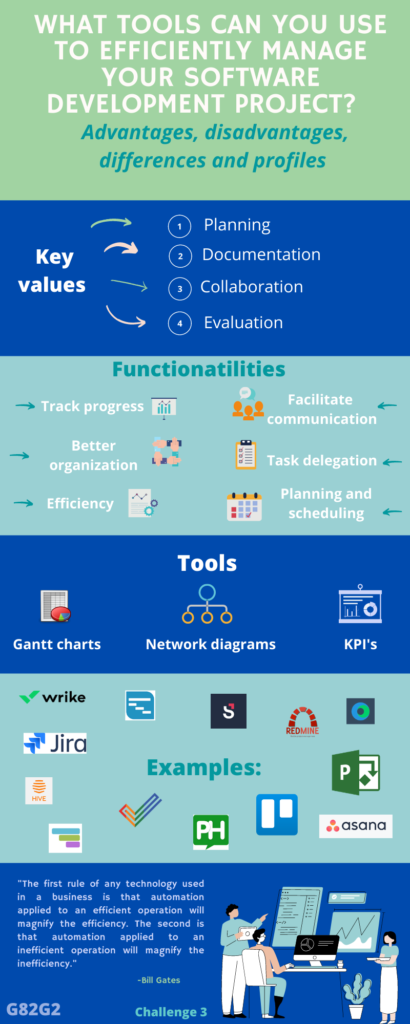
By using a Software Project Management Tool you will have:
Better coordination
A software project must be organized. However, it is not intuitive to choose the timing of the activities that have to be carried out. Therefore, planning is crucial. In addition, we will identify the connection links between the different tasks, which will allow us to prioritize them. Thanks to these tools, the client, the project manager and the team can clearly define objectives and the methodology. A better coordination will allow better cost, risk and time management.
Better communication and feedback
Communication between collaborators is essential to the success of any project. A project management software will enable different stakeholders to discuss, set alerts, know the advancements of the rest of the team and receive notifications.
In addition to these benefits, a project management tool also helps solve problems of document sharing and regular feedback. In a software development project, those tools will facilitate code sharing and collaboration between the programming team.
Better distribution of the workload
It is quite possible that at some point of the project, some collaborators are overwhelmed with work while others have less to do. A software tool can offer these functionalities:
- A calendar/schedule: in order to identify the tasks that have been executed, are in progress or are to be executed. Once this information is known, everyone will be able to better organize in order to meet the deadlines.
- A human resources management tool: will help better distribute the workload by identifying those who have the biggest loads and those who have the lightest.
Better evaluation of the project
Looking back on previous completed projects enables the company to learn from it. Those lessons will serve for future initiatives.
KEY ASPECTS FOR SELECTING TOOLS
The amount of offer of project management tools on the market can be overwhelming and the costs of failing to choose the right one, very high. So, the importance of choosing the most adequate project management tool should not be underestimated. To guide this decision, one must consider two important requirements:
- Make sure that the tool provides all the features needed by the project manager
- The entire team must be capable and willing to use it.
Get Prepared
Before choosing a tool and delving into the multiple existing offers, a team must set up clearly how they work and what issue they are willing to solve with the implementation of a project management tool. As we have seen, most project management tools are aiming at solving problems such as: missed deadlines and disorganized projects, lack of communication between team members, overwhelmingly packed emails inbox or time-wasting in meetings zaymer. Software management tools are sold as a product, and so they are sold with great marketing and promises of gains in productivity and efficiency. It comes to the responsibility of the project manager to make sure that he doesn’t fall for some marketed recommendations, but diligently picks the right tool that will serve his organization interests at best. Beside the direct application and gains a team wants to make from the implementation of a project management tool, one must also consider the size of the organization, the ease of use of the project management tool and its scalability across other projects or other parts of the organization.
Main Features of Software Management Tools
Planning/ Scheduling
Collaboration
Documentation
Evaluation
Planning or Scheduling
When one wants to implement a project management tool, it is to devise a project into interlinked activities and tasks. It is thus very important to have a clear view over all the tasks needed to be done and this can be made thanks to good planning and scheduling. You want to avoid having all the information scattered throughout the organization. A good project management tool should allow you to gather all this relevant information into a single place thanks to calendars, to-do-lists, templates, subtasks and folders.
Collaboration
We all have experienced the overwhelming feeling of a full email inbox, with no prioritization nor classification. Emails are great but they shouldn’t be the only means of communication and especially not between team members. Project management tools will allow for better collaboration between team members by allowing them to add comments over tasks, get specific notifications, build an organized dashboard and get assigned specific tasks. No need to communicate everything by email when you have implemented an effective project management tool that offers other means of communication and categorizes and updates automatically relevant information.
Documentation
Projects are often complex to manage and give rise to multiple different categories, sub-categories, folders and files that can easily become a nightmare to handle. To avoid getting lost with too many different documents, or face the tragic incident of a file disappearing, project management tools offer features such as storing files, versioning and editing.
Evaluation
Some tools also offer features like resource management and reporting that can help the project manager to track the progress, growth and productivity of a team.
…and then, each Software Management Tool available on the market will serve a combination of these features in a unique way …
A GUIDE TO HELP YOU IN THE SELECTION OF A TOOL
JIRA
Figure 2. Jira. Source: atlassian.com
Jira is a platform that facilitates collaboration between different stakeholders in a project, developed by the Australian company Atlassia. With more than 180,000 customers worldwide, the Jira platform is of great interest to many companies that have opted for it. This large number of customers creates a network effect for the product, which makes it more attractive to new users.
For the management of their projects, many other companies have shown great interest in Jira, which can meet the needs of different structures. For a perfect collaboration, for a clear work of the teams, the Jira platform is judged by many professionals as an exceptional tool. It is a solution that facilitates and helps development teams. The tool is aimed at finance companies, human resources departments, marketing departments… Bugs and requests are well monitored.
JIRA enables
- Collaboration Users are divided into three groups: customers, collaborators and agents
| Customers can access the Customer Portal free of charge to create a new request, view status of existing requests, add a comment. | Collaborators (managers) can view, comment and add attachments. | Agents have almost all the power. Indeed, they can create or process requests and communicate with customers. |
- Planification and defining milestones
JIRA uses Scrum which is an agile mindset. It is a process that regularly applies a set of good practices for working collaboratively. Thinking SCRUM means adopting an incremental development strategy, rather than a complete execution of the product. It enables overlapping the different phases of the project, rather than doing them one after the other in a sequential or cascading cycle. The tasks that are defined in a scrum project are called “Backlogs”.
One important concept is Sprint. “A sprint is a fixed time period in a … cycle where teams complete work from their product backlog. ” During that period, the team will work on some objectives of the project. This sprint will help you estimate the workload capacity of the team in such amount of time. You can also set the starting and finishing date of that sprint, add “Storytelling” and follow the advancement of the project members. Storytelling means talking about the project objectives, challenges and advancement in a non-technical way. This makes JIRA more user friendly.
- Reporting and advancement monitoring
| Burndown Chart to monitor the progress when generating. It allows you to track the progress of the work in a sprint and evaluate the effective ending time. | A sprint report enables you to supervise the progress. | This software also uses workflows to see the status of different tasks. There are 3 statuses: To do, In Progress, Done |
Limits/disadvantages of the tool
- Companies cannot customize the email templates sent to customers by the software (Exp: for adding the company logo or a personalized text).
- When an employee leaves the company, there is no direct process that allows a person to take over the same tasks in a project. Everything is done manually and it can take a long time.
- When canceling a project, retrieving the inventory is not an easy task.
ASANA
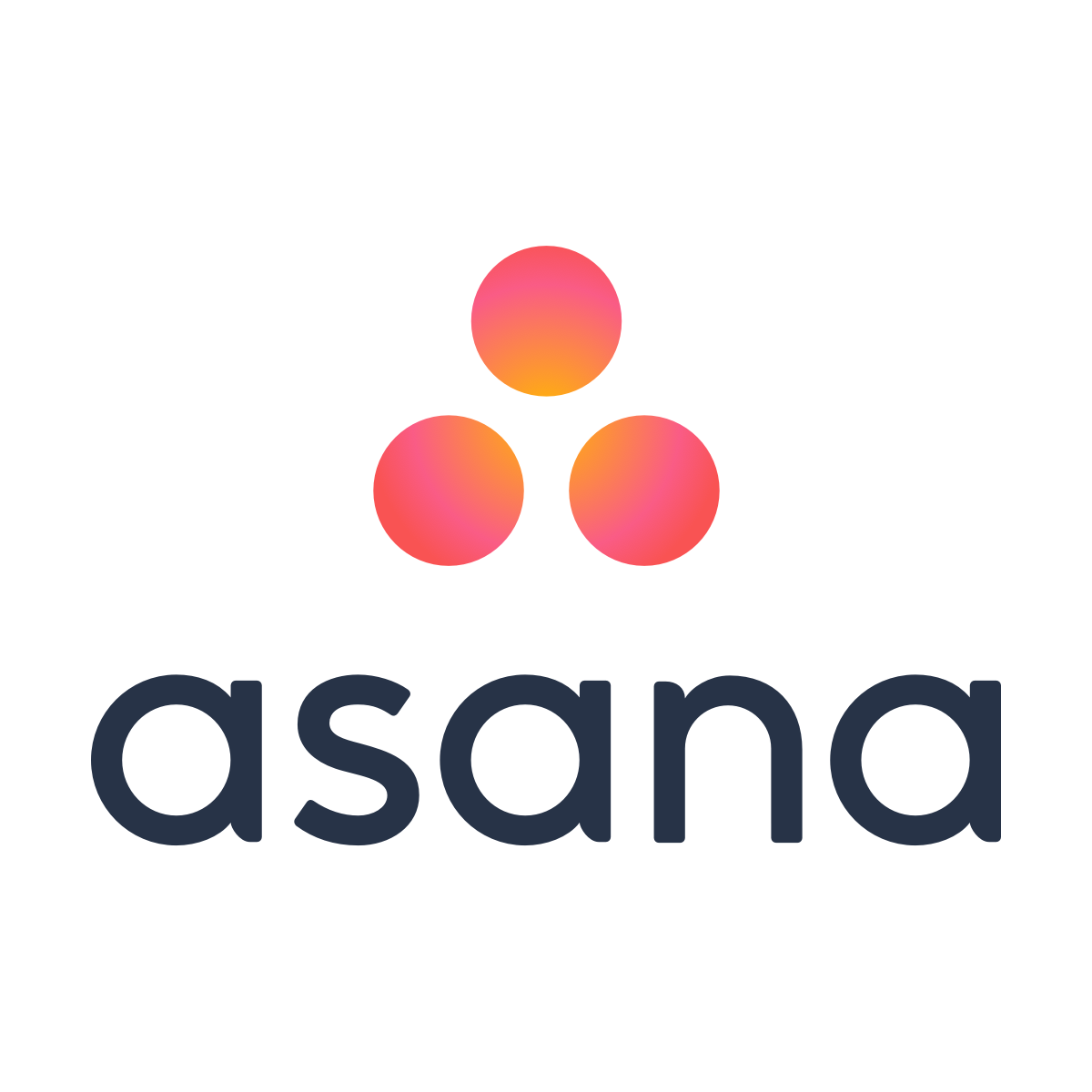
- Tariffs: Free for teams up to 15 people, Premium: €10,99/month, Business: €24,99/months, Enterprise: Customizable offer
- Integrable applications: Communication: Microsoft Teams, Gmail, Outlook, Slack, Vimeo and Zoom. Informatic and Development: Jira Cloud and Looker. Productivity: Google Agenda. Marketing and conception: Adobe Creative Cloud, Canva, Lucidchart and InVision. Sales and Services: Zendesk.
- Cloud based
- Pros: Integration capacities, extensions offer, flexibility and intuitive design.
- Cons: No task duration and task dependency feature
- Companies using Asana: More than 1000, including Deloitte, Vodafone, Uber, Dropbox, Spotify, Sundance, Quora or Google.
- Useful Tip: Most effective when combined with Instagantt
Asana is a cloud based project management tool and one of the most popular one on the market. It supports teams in organizing, tracking, and managing their work. Asana was introduced in 2008 by two ex-Facebook workers aiming at improving team collaboration and task management. Today, more than 1000 companies across all industries reported using Asana, including Uber, Airbnb, and Dropbox.
Asana enables
One of the most distinguishable features of Asana is its great integration capacities and extensions offer.
Most companies are already using collaboration tools such as file sharing (Google Doc), emails (Gmail, Outlook…), and instant messaging (Slack, Zoom…). Those collaboration tools are great, but often dispatched and poorly organized. When you decide to integrate a new software management tool, you do not want to change your entire organization’s operation management. This is made possible by Asana’s diverse extensions (Asana for Gmail, Asana for Outlook…) and integration capacities that will make it possible for a company to gather all its different sources of information into one clear and cohesive system suitable to any business area. Asana’s integration capacities include software tools from various domains such as: Communication, Informatics and Development, Marketing and Conception, Productivity and Sales and Services.
Besides these integration and synchronization features, Asana offers great work tracking options with its own and unique features. Through the creation of individual task lists shareable across team members with deadlines and task status team members can coordinate effectively their activities. They can also continuously follow what others are doing by subscribing to specific tasks and getting notified when modified. Asana also offers a note taking application so that team members can publicly or privately post comments on tasks and register new ideas for a project.
Limits/disadvantages of the tool
- Not very friendly for new users.
- Some users can get lost among too many features
- The tasks can only be assigned to one person
- There are no time tracking features
- There are limited exporting possibilities
REDMINE
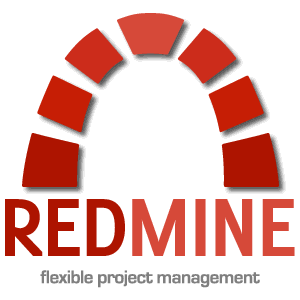
- Tariffs : Free
- Pros: Great customization capabilities, Gantt Chart are included
- Cons: Not simple to implemant and use
- Useful tip: Upgrade Redmine with plugins as Resources plugin, Reporter plugins, Help Desk plugins or Invoices plugins. Redmine is better suited for software development teams.
Redmine is an open-source, free project management tool and issue (bug/feature/task) tracker system with great customization capabilities. The first version of Redmine was released in 2006 and since then an active community has been constantly working on optimizing the initial code.
An open-source tool enables
Redmine is mostly known as a project management tool, but was in fact conceptualized as a bug-tracking and issue management tool. With extra plugins and customizations (that take time and money to install) Redmine can be used as a project management tool. At first, Redmine was designed to help programmers share their code, track bugs and issues and handle feature requests.
A user of Redmine can add a task that he can choose to classify as a bug, an issue or a feature request. This task can be shared among all team members that can get notified when the task gets modified. There is no time tracker on Redmine, but it offers the possibility to assign a raw number to a task in order to indicate how long it took to get completed. One all the tasks are implemented in the system, the users can review them taking different perspectives, under a calendar, a task list or a Gantt chart. Regarding the communication between the members, it is mainly enabled by wikis through which members can comment tasks, keep documentation or add notes. Regarding the integration possibilities, it is like the extra features, they are possible, but they require know-how and time to implement.
Limits/disadvantages of the tool
Choosing an open-source software comes with the great advantage of being completely free, but requires trained persons able to install it and maintain it. Open-source project management tools are thus best suited to software development teams that have this specific know-how. Even though the access to Redmine is completely free, it is important to keep in mind that costs can emerge from other sides. Implemantion costs, costs to install customized updates and recommended plugins and costs of maintenance as no third party are responsible for it.
PROOFHUB
Figure 5. ProofHub. Source: pcmag.com
- Tariffs: Essential plan: 45$/month, Ultimate control plan: 135$/month
- Integrable applications: Google Docs, Dropbox
- Pros: Quick and easy set-up, Competitive prices
- Cons: Limited integration capacities, the interface should be improved
- Useful tip: Good tool for working in small teams, but should get upgraded for bigger teams
Proofhub is an all-in-one project planning software and one of the most popular project management software nowadays. Simple platform that has limited integrations and features. This tool provides applications for project management. Some of the key features that we can find are discussion, notes, gantt charts… Apart from online collaboration in this software we can find tools for communication, progress tracking, visibility… Supports integration for Google docs and Dropbox.
ProofHub enables
- Define specific roles and access restrictions according to the organization workflow.
- Shows a clear agenda of the day: schedule with recurring tasks, automatic reminders and multiple calendar views.
- Lets you create your own workflow
- Communication flows between team members are fastened, allows for better efficiciency and coordination
- Mobile app
- Streamlines the feedback shearing process (progress tracking): allows the user to create the parameters of their choice to plan ahead.
- Easily integrate with third party apps
- Possibility to change the ownership of the account to pass the responsibility to others
Limits of the tool
- Limited integration: the integration with third party apps is really limited. (Google Ads, ICal and Fresbooks)
- Improve interface: some parts do not work properly
- Missing messages and tasks: messages in group chats sometimes do not appear and some tasks disappear.
- Good for work on small teams but it needs to improve for bigger teams
ZOHO PROJECTS

- Tariffs: Up to 3 users: Free, Up to 50 users: 5€/user/month, No limit: 10€/user/month
- Integrable applications: Other Zoho’s Software, Google Ads, Microsoft Office, GitHub,
- Pros: Bug and Issue tracking, multiple task tracking at the same time possible, greatly customizable, Gantt Chart and Resource Utilization Chart can be used together
- Cons: high learning curve, no template, some features need improvements
- Useful tip: ZohoProjects can be imported to other Software Management tools such as Jira, Microsoft Project or Basecamp
Zoho Projects is a cloud-based tool. It is used by very well known companies such as Dell or Vodafone (Zoho, 2021). However, more focused on the post’s topic, Zoho Projects has allowed the software development company, Simform, to increase the productivity of its team by 30% as well as reducing task allocation times and optimizing its performance (Dhaduk, H., 2021).
ZohoProjects enables
- Bug and Issue tracking – for software developers bug tracking is an essential part of the process. Zoho Projects does not only allow them to use IssueTracker (integrated in it), but also to import bugs from CSV, XLSM… or even from Jira.
- Automation and advanced reporting in order to save valuable time.
- Time tracking – a really special feature is that more than one task can be tracked at once.
- Dependency management – easy to create using the Gantt Chart for the subphases of the process that can be performed separately.
- Milestone tracking in order to inform the team about the tasks that have not been already completed.
- Customization – other tools do not allow too much customization. However, Zoho Projects workflows, statuses, fields and notifications can be customized. The main problem, however, is that it does not have any kind of template
- Collaboration – it allows software developers to share documents between them related to the process, to mention different team members, to comment and chat in forums.
- The Gantt Chart can be used together with the Resource Utilization Chart in order to allocate resources as efficiently as possible. This Resource Utilization Chart is shown as a timeline, different from the table form of other tools.
Furthermore, Zoho Projects can be integrated with other Zoho’s Software or even with Google Apps, Microsoft Office, GitHub,… However, the most important aspect is that it can be imported to some other Software management tools such as Jira, Microsoft Projects or Basecamp.
Limits/disadvantages of the tool
Many Zoho Projects users agree on its main disadvantages: high learning curve, poor dashboard functionality, some features such as bug reporting and task management need improvement.
TEAMGANTT

- Tariffs: For one project of personal use: Free, Standard plan: 25$/user/month, Advanced plan: 30$/user/month
- Pros: Ease of use, Kanban board, Gantt Chart, Calendar view
- Cons: Costly for big teams, almost no third-party integration possibilities, no budget section
- Companies using Teamgantt: Netflix, Amazon or Intuit
TeamGantt provides user-friendly Gantt Charts online.
Used by companies like Amazon, Netflix or Intuit, TeamGantt’s notable advantages are: its ease of use, the fact that all projects can be seen in one screen and the report comparison between actual and planned timeline is enabled. Furthermore, tasks can be seen in calendar view or list format. Kanban board, Gantt Chart or Calendar views can be easily switched. Its mobile app makes collaboration between users easier. Another advantage that should be noted is that functionalities do not vary from Mac to PC version.
Team collaboration is enhanced by visual sticky notes, availability check before assigning resources, remote synchronization…
Taking into consideration the third-party integration of other tools like Zoho Projects, it can be said that third-party integration of TeamGantt is almost null.
The fact of not having a budget section is considered a disadvantage by many people.
BASECAMP

- Tariffs: Basecamp personal: limited, but free. Basecamp Business: 99$/month
- Pros: low implementation costs, supports integration with third-party apps
- Cons: No task tracking, simple features, limited customization possibilities
- Useful tip: Very good software management tool for simple projects
Basecamp is a classic project management tool. It combines project management with internal communication, making it perfect for team collaboration.
Basecamp enables
Advantages
Limits/Disadvantages
- Message board
- To-do lists: with multiple levels and features
- Schedules
- Documents and files
- Group chats
- Automatic check ins
- Integration with third party apps
- Mobile app
- Easy to set up and flexible
- Support integration with a wide variety of apps and services
- Availability to create client’s specific projects: allows the users to add specific clients to the project and share project details with them.
- There is no task tracking: when someone is working on a project it is important to be sure that the project is going to be on time
- Simple features: need improvement to include more advanced features
- Limited customization: users complain about the limitations of customized settings
TRELLO
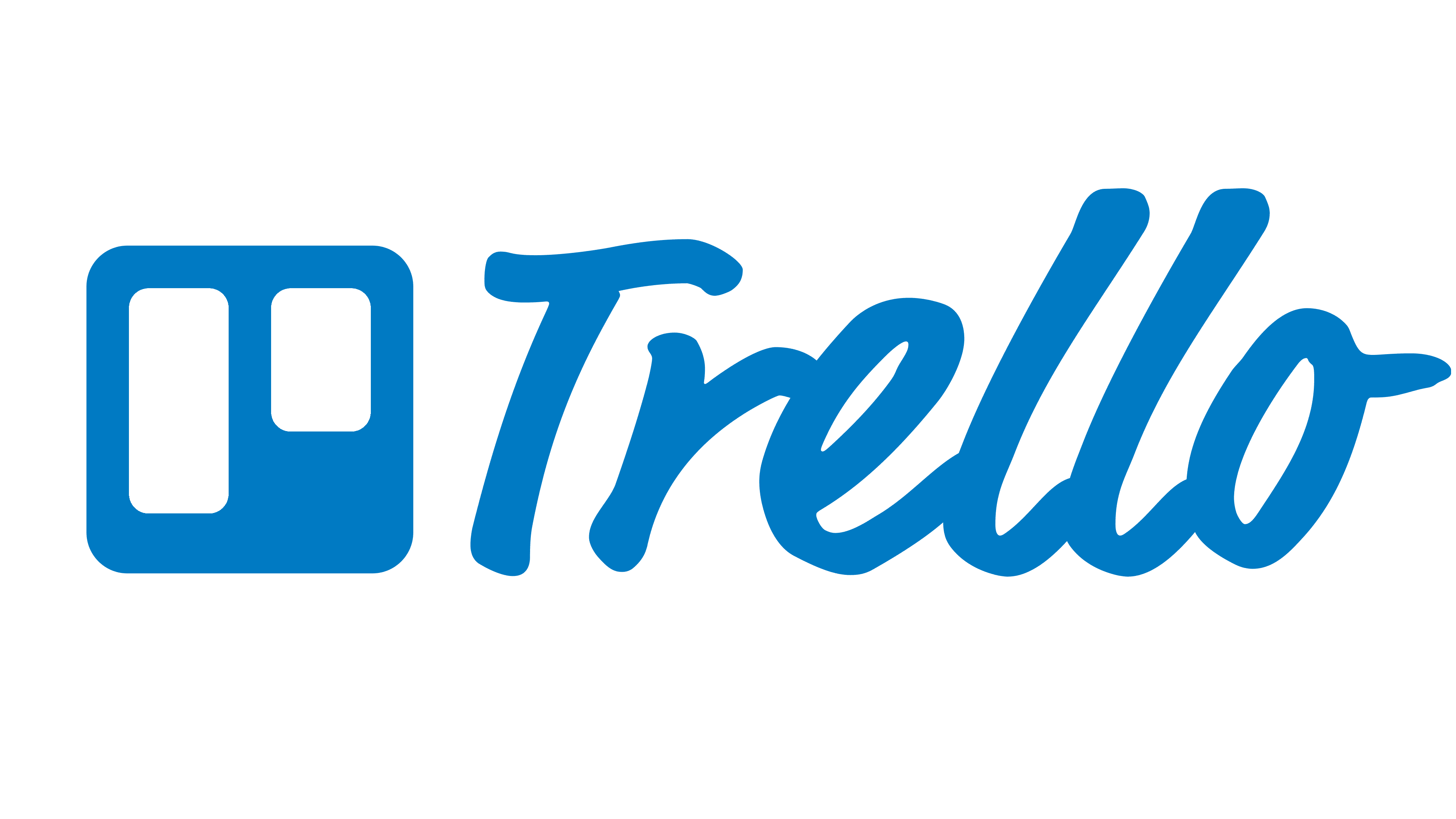
- Tariffs: Free option with limited features, Business Class: 10$/user/month, Enterprise: customizable option
- Integration capabilities:
- Pros: very intuitive
- Cons: Poorly advanced communication tools
- Useful tip: Better to use for a project managed by a single user
Trello is a software development tool commonly used because of its ability to make workflow easier. It is one the most intuitive apps.
It offers boards, lists and cards that allow you to organize yourself and your team in a flexible way, it tells you what you are working on, what has previously been done…. Among its features, there are also adding comments, setting due dates and uploading attachments that make collaboration between team members easier.
This tool also makes it possible to prioritize actions and monitor progress, boosting software developer productivity.
Trello enables
Advantages
Limits/Disadvantages
- Detailed overviews
- Information Backup
- Individual and group task management
- Voting options
- Automated email notifications
- Deadline alerts and notifications
- Flexible and customize Kanban App
- Offers desktop and mobile apps
- Intuitive interface what makes the use of this toll easier for the user
- For general management projects only
- Communication tools are not good enough, can be a disadvantage when the user work in teams
ADVANTAGES / DISADVANTAGES QUICK GUIDE
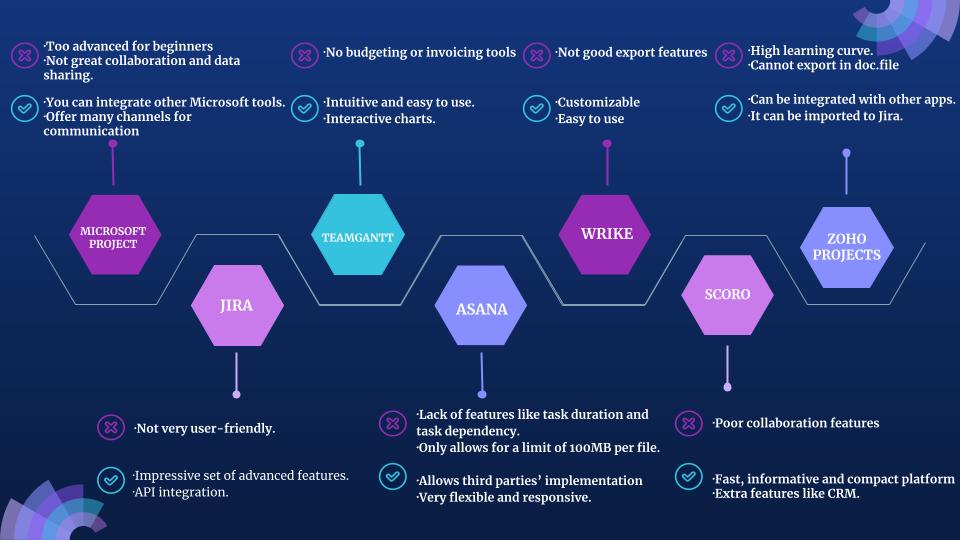
A COMPARISON: TOOLS WITH SAME FUNCTIONALITY
The following table shows a summary of all the functionalities the analysed tools have. The differences between the different tools can be clearly seen, as well as their strengths and weaknesses.
The “check mark” or “tick mark” means that the tool has the specific feature marked.
The “red face” symbolizes that besides not having the specific feature, the tool presents completely the opposite characteristic. The “green face” symbolizes that besides having it, it should be remarked as one of the main features that distinguishes the specific tool. The “yellow face” symbolizes that the tool does not fully present such a feature.
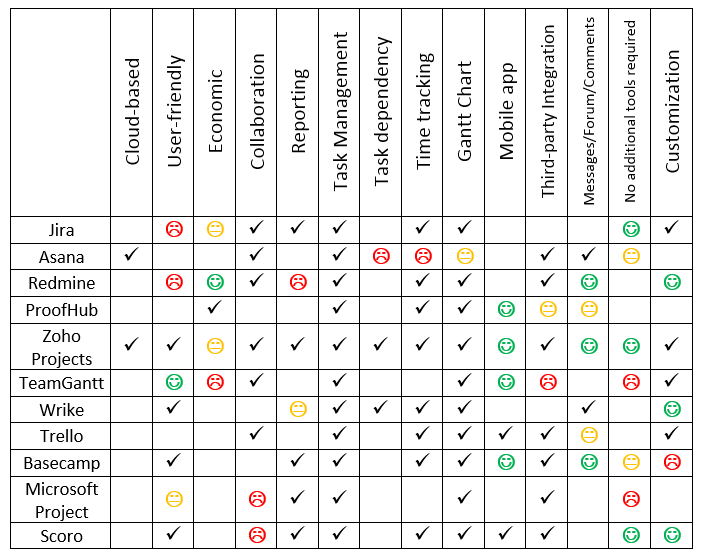
TOP 3 TOOLS ACCORDING TO QUALITY, COSTS AND TIME
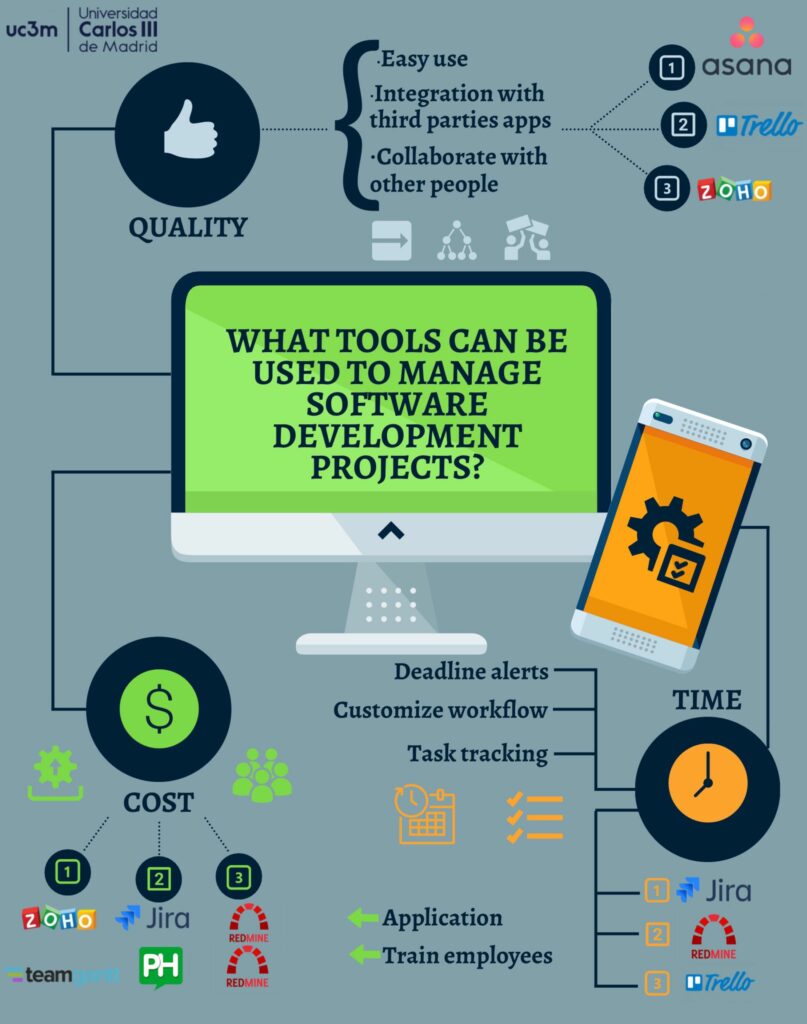
CONCLUSION
When a business decides to implement a software development project, people do not have the time to become experts in software management and development theory. In fact, what they need is not theory but rather a practical guide to manage it.
Software project development is a complex process that requires testing, maintenance and a really good management team so for the project not to fail, it is necessary to have lots of resources such as budget, staff and time; resources that have to be really well managed if one wants the project to succeed. It is at this point that the different tools analysed take center stage.
This post exhibits the different utilities each tool has that will assist the company throughout the evolution of the development project. The choice of which application is better will depend on the preferences of the company, but it should be said that the use of these applications will help the company to do a better job when developing a software project.
Alexia García Mesa I am a Management and Technology student at the Universidad Carlos III de Madrid. I am interested in Big Data and I want to focus my studies on this area. I really love painting and going for a walk with my family and my dog.
Ana Valeria Garrido de Castro. I am a Politics Science student at Carlos III university. I take business and technology classes on the side because I would like to create a business of my own. With my free time I enjoy spending it with family, friends and food!
Insaf Allani. I am Tunisian and I moved to France 6 years ago to pursue my higher education. I am preparing for a double degree as an Engineer/ Manager and currently an Erasmus student at UC3M. My field of study is Data, Network and Security. I love dancing and travelling.
Sophie de Blonay. I am a student in Management from Switzerland and currently in Madrid for an Erasmus at UC3M. My ambition is to help businesses in their transition to more sustainable and inclusive business practices. I love french literature and travelling!
Nicole Vásquez Muñoz. I’m from Ecuador and 4 years ago I decided to move to Madrid to get my degree in finance and accounting plus a minor in management and technology. I love travelling, discovering new places and learning about different cultures and traditions.
María Roca Mengual. I am a Management and Technology student at Carlos III university. I’m really interested in new technologies and how we can apply for entrepreneurship, especially in digital marketing. I love travelling and learning new languages.

#funsoft, Communication, Project Management, Reasoning and Planning, Software Development, Software Productivity, Team collaboration
